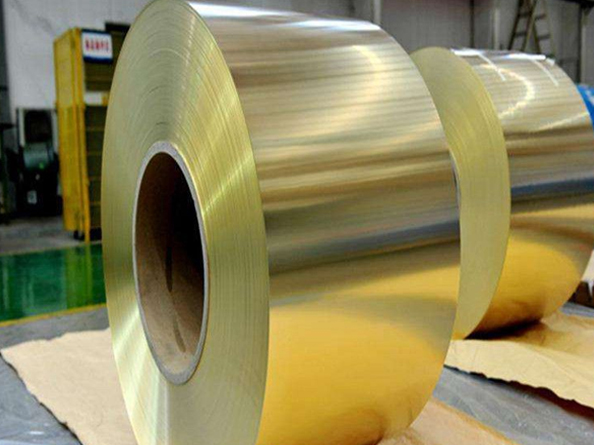- Chinese
- Join the Favorites
- MESSAGE
- sitemap(Baidu / Google)


Chemical Composition
| Alloy Grade | Cu | Fe | Pb | Ni | Zn | Impurity |
| C28000 | 57.0-60.0 | 0.3 | 0.5 | 0.5 | margin | 1 |
| C28000 | 60.5-63.5 | 0.15 | 0.08 | 0.5 | margin | 0.5 |
| C27000 | 63.5-68.0 | 0.1 | 0.03 | 0.5 | margin | 0.3 |
| C26200 | 67.0-70.0 | 0.1 | 0.03 | 0.5 | margin | 0.3 |
| C26000 | 68.5-71.5 | 0.1 | 0.03 | 0.5 | margin | 0.3 |
| C24000 | 79.0-81.0 | 0.1 | 0.03 | 0.5 | margin | 0.3 |
| C23000 | 84.0-86.0 | 0.1 | 0.03 | 0.5 | margin | 0.3 |
| C22000 | 88.0-91.0 | 0.1 | 0.03 | 0.5 | margin | 0.2 |
| C21000 | 95.0-97.0 | 0.1 | 0.03 | 0.5 | margin | 0.2 |
Mechanical Properties
| Alloy Grade | Melting Temperature ℃ | Boiling Point ℃ | Density kg·(kg·mˉ3) | C J·(kg·℃)ˉ1 | Coefficient of Linear Expansion | Thermal Conductivity W·(m·K)ˉ1 | Conductivity %IACS | Conductivity %IACS | Resistivity μΩ·m | ||
| Liquidus | Solidus | Solid state | Liquid state | ||||||||
| C28000 | 896 | 886 | 8400 | 21.0X10ˉ6 | 125.1 | 0.0025 | |||||
| C28000 | 906 | 899 | 8430 | 20.6X10ˉ6 | 116.7 | 27 | 0.071 | 0.0017 | |||
| C27000 | 936 | 906 | 8470 | 20.1X10ˉ6 | 116.7 | 27 | 0.067 | ||||
| C26200 | 939 | 910 | 8500 | 20.0X10ˉ6 | 116.7 | 27 | 0.064 | 0.0015 | |||
| C26000 | 951 | 916 | ≈ 1150 | 8530 | 0.09 | 19.9X10ˉ6 | 120.9 | 28 | 0.062 | 0.39 | 0.0015 |
| C25000 | 981.2 | 8630 | 19.6X10ˉ6 | 120.9 | 30 | 0.057 | |||||
| C24000 | 1001.2 | 966 | ≈ 1240 | 8660 | 0.093 | 19.1X10ˉ6 | 141.7 | 32 | 0.054 | 0.33 | 0.0015 |
| C23000 | 1026.3 | 991 | ≈ 1300 | 8750 | 0.095 | 18.7X10ˉ6 | 151.7 | 37 | 0.047 | 0.29 | 0.0016 |
| C22000 | 1046.4 | 1026.3 | ≈ 1400 | 8800 | 0.095 | 18.4X10ˉ6 | 187.6 | 44 | 0.04 | 0.27 | 0.0018 |
| C21000 | 1071.4 | 1056.4 | ≈ 1600 | 8850 | 0.093 | 18.0X10ˉ6 | 243.9 | 57 | 0.031 | 0.24 | 0.0027 |
Introduction
Copper plate is a highly stable, low maintenance roofing and curtain wall material that is environmental, safe to use, easy to process and highly resistant to corrosion. A stable protective layer allows the life of the copper plate to exceed 100 years. The economic performance of copper plate is one of the best metal roofing materials.
1) The yield strength of the copper plate is inversely proportional to the elongation. The hardness of the copper plate after bending processing is extremely high, but it can be reduced by heat treatment.
2) Among all the metal materials used in construction, copper has the best extension properties and has great advantages in architectural modeling.
3) The copper plate is not limited by the processing temperature, and is not brittle at low temperature, and can be hot-melt welded by oxygen blowing at a high melting point.
4) Fireproof, non-combustible material.
5) Even in extremely corrosive atmospheres, copper plates form a strong, non-toxic passivation protective layer, which is commonly called "verdigris." The chemical composition depends on the air conditions in the area, but the "verdigris" of various compositions has the same protective effect on the copper. This layer of passive film is very stable and can be repaired automatically by damage. It is difficult to distinguish with the naked eye.
Application
The copper plate has excellent processing adaptability and strength, and is suitable for arcing, trapezoidal, cornering etc. in various processes and systems such as a flat lock system, a vertical edge occlusion system, a BEM system, a unit wall plate, and a rain drainage system.
A variety of surface treatments to meet different architectural needs.
(1) A copper oxide sheet can form a uniform brown appearance.
(2) The patina board is used for renovation of old buildings or new construction with special requirements.
(3) The original copper plate has a gradual change in metallic luster, making the building as life-like.
(4) Tin-copper plate can achieve the effect of titanium-zinc plate.
Copyright © Shanghai Changyu Copper Co., Ltd.address:No. 5800 Shenjiang Road, Pudong New District, Shanghai, China Record number:沪ICP备18044494号